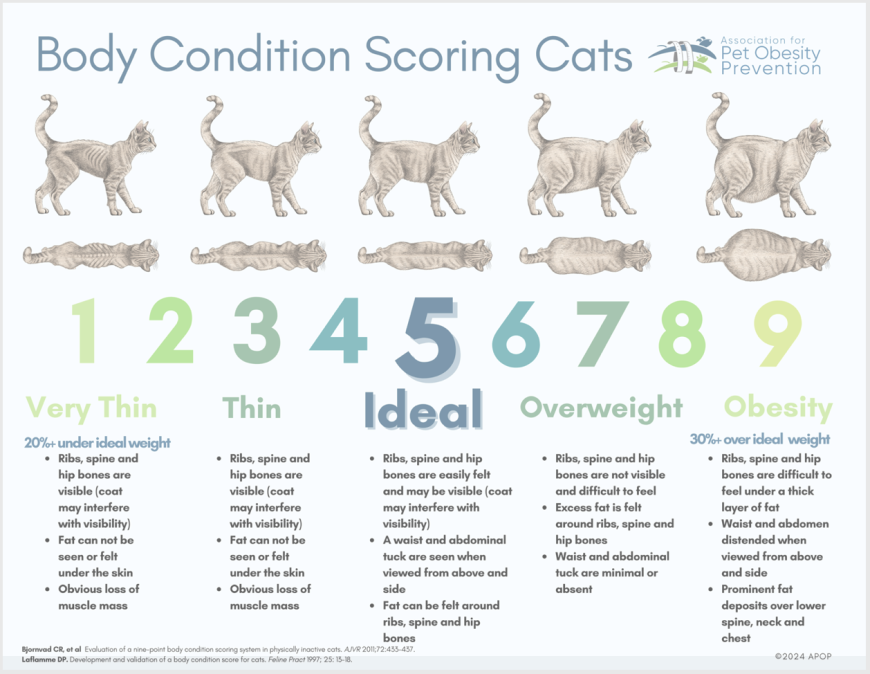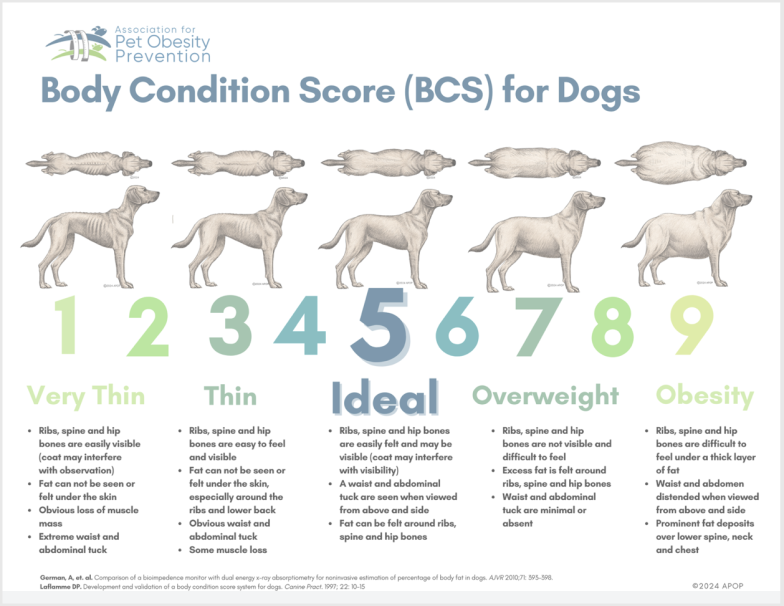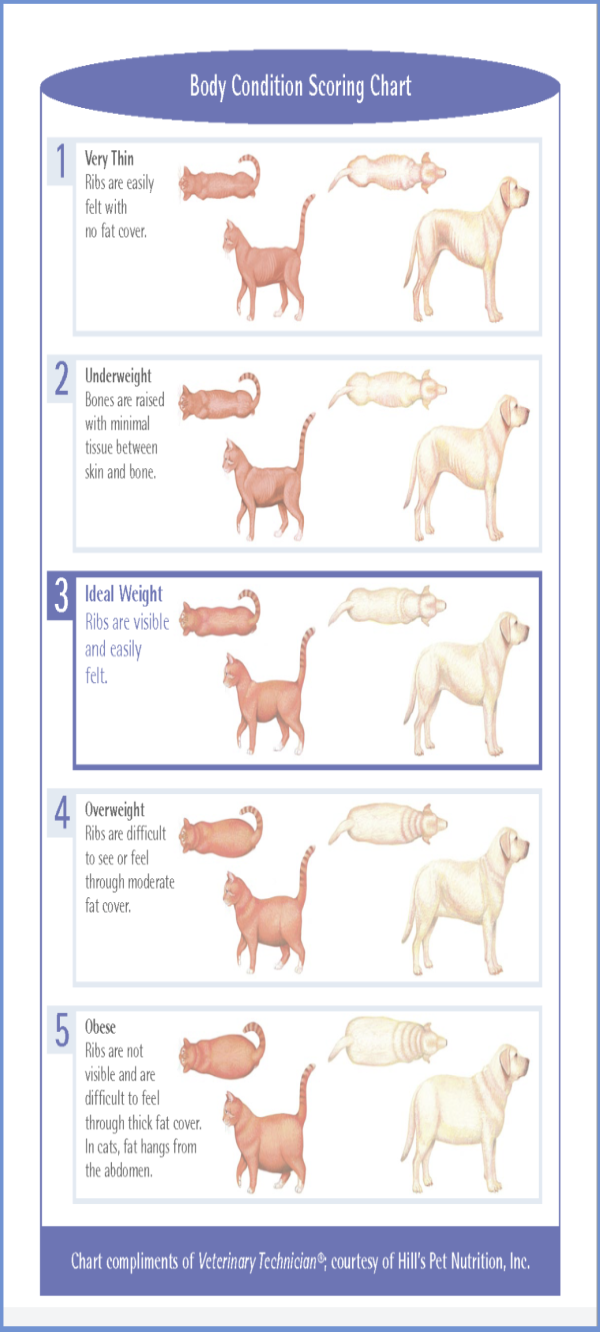Is My Pet Fluffy or Fit? The Truth About Body Condition Scores
Last weekend, my daughter called me with the excitement that only a first-time pet parent can bring; she had just adopted her first dog. Within hours, the questions came pouring in: Which vaccines are urgent? How do I teach her to walk on a leash? What should I feed her?
But one question stood out. “I think she’s starving to death,” my daughter said. “I’ve been feeding her tons of puppy food, but she still looks skinny. You can see her waist and her ribs!” As a veterinarian who specializes in pet nutrition, I paused and asked her one simple but important question: Is she underweight, or is she healthy?
I pulled up a Body Condition Score (BCS) chart. We walked through it together and quickly realized the truth: her puppy was a perfect 4 out of 9, an ideal score for a growing, lean puppy. Not underweight, not overweight, but just right.
This small but powerful conversation highlights a much larger issue in pet health today: limited awareness and use of Body Condition Scoring among pet owners, and sometimes even among professionals. In this two-part series, we are first going to look at what BCS is and how to assess your pet’s BCS at home. Then in the second part, we will look at why an accurate BCS is essential for pet health, and the disconnect between pet owners’ perceptions of body condition versus the reality.
What Is a Body Condition Score?
A Body Condition Score (BCS) is a standardized, visual, and tactile assessment used by veterinary professionals and pet parents alike to evaluate a pet’s body condition and fat and nutritional status—to an extent. Body Condition Scoring charts come in two different scales: a 1-9 scale, with 1 being emaciated and 9 being obese (5 out of 9 is ideal weight); and a 1-5 scale, with 1 being emaciated and 5 being obese (3 out of 5 is ideal weight).
These scales, while standardized, are subjective. Body Condition Scores go beyond the number on the scale. While they can assist in providing a personalized picture of health, in their truest form, they do not account for breed, age, muscle mass, or skeletal structure. However, these factors can play a role in the interpretation of the results.
Additionally, a muscle conditioning score can help evaluate muscle mass. This is like the direct assessment veterinary version of the human Body Mass Index (BMI), which is an indirect assessment. Body Condition Scores are arguably more accurate because they account for body composition (to a degree) and, as mentioned previously, breed and body type can affect the interpretation of results, unlike a weight-to-height ratio like BMI. Charts from reputable veterinary sources (e.g., WSAVA or APOP) are great visual tools.
While BMI is purely mathematical (weight (kg) / [height (m)]2), BCS is a hands-on assessment. To conduct a BCS, one must feel the specified areas on the animal, provide an observation, and correlate it to a score on the scale. A Greyhound’s visible ribs may be normal; a Bulldog’s lack of a waist may not be. BCS helps decode these breed-specific norms.
How to Use a BCS Chart at Home
Pet owners can and should learn how to assess their pet’s BCS regularly. BCS involves evaluating the visibility and palpability (ability to be touched and felt) of ribs, waist, and abdominal tuck. Here’s a simplified step-by-step guide:
- Look from above – Does your pet have a visible waist behind the ribs? Does their body look oval or round?
- Feel the ribs – You should be able to feel the ribs easily with light pressure, but not see them prominently (unless your pet is a sighthound).
- Check the belly – A tucked-up abdomen (not sagging) is ideal in dogs. For cats, you’ll want a slight upward slope from the ribcage to the pelvis. It is okay for cats to have what is known as a primordial pouch (that extra, flappy skin on some cats bellies) but you should still be able to easily touch the ribs and notice a line of their abdomen that tucks up from ribcage to waist.
When in doubt, you can always consult your veterinarian to confirm your assessment.
Using the Chart Without Judgment
Body Condition Scoring is not about shame—it’s about science. When we use it correctly, it empowers us to make better feeding and care decisions. A pet’s health depends on accurate, routine assessment, not guesswork.
Understanding and regularly assessing your pet’s Body Condition Score is one of the most valuable tools a pet owner can use to support lifelong health. It moves us beyond guesswork and emotional perceptions and into evidence-based care that prioritizes your pet’s well-being. By learning to use the BCS chart at home and seeking veterinary guidance when needed, you become an active partner in your pet’s health journey. Whether it’s helping a growing puppy maintain a lean body or recognizing when a beloved senior cat may need a dietary adjustment, BCS empowers us with knowledge and compassion.
In part two of this series, we’ll explore how accurate body condition assessments can prevent chronic disease, enhance quality of life, and support healthier, happier years together. Stay tuned!
Follow us on LinkedIn for the latest updates on all things happening here at BSM Partners.
About the Author
Dr. Katy Miller works as the Director of Veterinary Services at BSM Partners. She earned her veterinary degree at Ross University and completed her clinical year at Louisiana State University. She previously served for 11 years as the Director of Dog and Cat Health and Nutrition for Mud Bay where she earned multiple certifications and specialized in pet food nutrition, prior to which she practiced general and emergency medicine for seven years. She is also a competitive three-day eventer, licensed falconer, and claims only two (Golden and Mini Doxie) of their nine dogs.
This content is the property of BSM Partners. Reproduction or retransmission or repurposing of any portion of this content is expressly prohibited without the approval of BSM Partners and is governed by the terms and conditions explained here.


